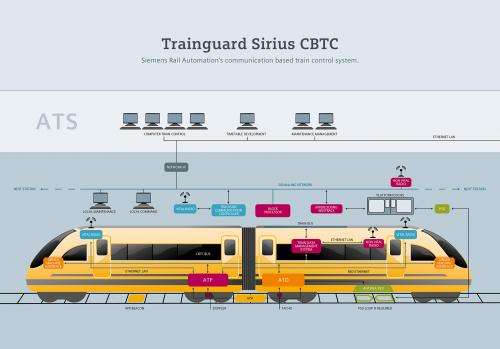Driverless subway line to be extended in Paris

The Paris public transportation company Régie Autonome des Transports Parisiens (RATP) is extending its network of driverless subways by six kilometers. Siemens will equip the new section of Line 14 with signaling and operation control technology. The route's four new stations are scheduled to go into operation in 2019. The contract is worth around €45 million.
Driverless subways have been used in Paris for the past 25 years. In 1998 Siemens installed this technology in the original stretch of Line 14, creating the first fully automatic subway route in the French capital.
Driverless operation increases a subway line's capacity by up to 50 percent, because the trains can travel at shorter intervals. In Paris, the fully automatic operation enables the trains to run every 85 seconds. Additional trains can be deployed whenever larger numbers of passengers are expected - during major events, for example. The trains, which automatically go into operation at the push of a button, can also be inserted into gaps in the schedule at short notice.
Moreover, the subway's automatic energy-saving operation enables Line 14 to consume up to 15 percent less energy. The system's intelligent anticipatory driving style ensures that travel times are always optimally scheduled. As a result, trains don't arrive ahead of schedule, because they automatically adjust their speed to avoid unnecessary energy consumption.
Automatic operation reduces energy consumption by 15 percent
Siemens is the market leader for driverless subway signaling systems, which it has installed on around 250 kilometers of routes all over the world. For the extension of Line 14 in Paris, Siemens is using the automatic train control system Trainguard MT, which was developed by Siemens Corporate Technology (CT) in cooperation with other partners. This communication system uses WLAN to register the position of each train with a precision of a few centimeters and automatically adjusts the distance between a train and the vehicle behind it. A critical factor for increasing capacity is the distance between two trains, which is based on the maximum braking distance that must be maintained. This used to be a fixed distance. But because Trainguard MT knows the precise location of each train, it can adjust the spaces between vehicles to the actually required braking distances, enabling the subway to run more often.
In addition to installing Trainguard MT in the existing Line 14, Siemens also fitted the system into Line 1 in 2011 to equip it for driverless operation. Metro Line 1 is the most heavily used subway line in the French capital. The approximately 17-kilometer-long route connects the eastern and western parts of the city and transports up to 725,000 passengers each day. This was the first time that a subway line of this importance was automated without interrupting train service.
Provided by Siemens





















